Beaumont Begins New Proton Therapy Center
 ROYAL OAK, Mich. — Construction has begun on a new Proton Therapy Center at Beaumont Hospital’s Cancer Institute in Royal Oak. Proton therapy is a newer, high-tech alternative to treating certain cancers. The benefits include a scanning beam of proton radiation with online image guidance offers greater precision to destroy cancerous cells, sparing healthy tissue with fewer side effects. This will be the first single-room proton treatment center of its kind in Michigan.
ROYAL OAK, Mich. — Construction has begun on a new Proton Therapy Center at Beaumont Hospital’s Cancer Institute in Royal Oak. Proton therapy is a newer, high-tech alternative to treating certain cancers. The benefits include a scanning beam of proton radiation with online image guidance offers greater precision to destroy cancerous cells, sparing healthy tissue with fewer side effects. This will be the first single-room proton treatment center of its kind in Michigan.
When completed, the two-story Proton Therapy building will be 25,200-square-feet, including a basement. The first floor will house the Proton Therapy Center. This 10,000-square-foot space will include a cyclotron that produces the proton beams and a single-room treatment area. It should be completed in two years at a cost of $40 million. The first patients will undergo treatment at the Proton Therapy Center in the spring of 2017. The 8,000-square-foot second floor will house Beaumont Children’s Hospital’s Pediatric Oncology and Hematology program.
“This technology will allow us to define future treatment strategies for cancer, “ said Craig Stevens, chairman, radiation oncology, Beaumont Health System, in a statement. “We will have the capability to retreat cancer that would have otherwise been considered unsalvageable and incurable.”
While proton therapy is not effective against all cancers, Dr. Stevens explained it can be very effective in treating solid and localized tumors, including some pediatric cancers, soft tissue sarcomas, brain tumors and head/neck cancers.
Adds Dr. Stevens, “Proton therapy is ideal for tumors close to vital organs.”
Beaumont has chosen Ion Beam Applications of Belgium, also known as IBA, to install and maintain the proton system at Beaumont Hospital, Royal Oak. Jones Lang LaSalle at Beaumont will oversee design and construction. Kasco Construction is the contractor and SmithGroupJJR is the architect.
Proton therapy uses high-speed protons to fight cancer by aiming a high-energy ionizing beam at the tumor, destroying its cells. A cyclotron, or particle accelerator, creates protons from hydrogen molecules spun at extremely high speeds. They travel up to 2/3 of the speed of light. The proton beam is sent to a treatment room through a transport system consisting of magnets, called the beam line, finally arriving in the gantry. The gantry is a device that rotates around the patient delivering a beam of protons. The beam is directed to the patient through a nozzle that targets the tumor.
IBA’s ProteusONE single-room treatment system uses Intensity Modulated Proton Therapy, or IMPT. It combines Pencil Beam Scanning, a proton beam delivery mode, with 3-D Cone Beam Computed Technology for real-time imaging during treatment. The patented cone beam technology was developed by researchers at Beaumont.
“This technology is very precise. Real-time CT image guidance can target a tumor with millimeter precision,” says Dr. Stevens.
Presently, there are fewer than 50 proton therapy centers worldwide.
Along with hundreds of construction jobs, Dr. Stevens estimates the new Proton Therapy Center will create at least 30 clinical positions at Beaumont.
Beaumont has developed this project in cooperation with Proton International, an Atlanta-based proton therapy development group with expertise in all phases of proton therapy development and operations.
